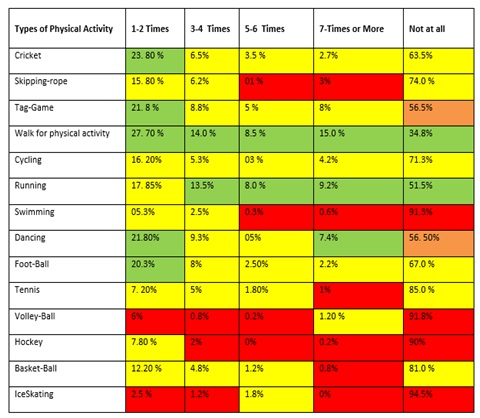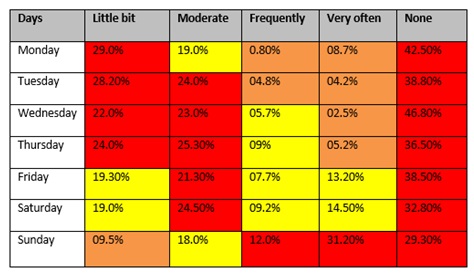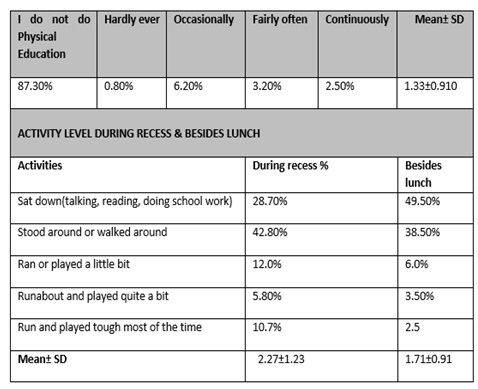ABSTRACT
BACKGROUND AND AIM: Physical inactivity and obesity are the two emerging problems in Pakistan. Schools have been identified as an essential setting for health promotion through physical activity participation. Many schools in Pakistan mainly concentrate on the higher study level and insufficient attention towards children’s physical health that may impair due to low physical activity level and increased sedentary behavior leading to obesity and other health issues. The study aims to assess the level of physical activity in school children.
METHODOLOGY: A cross-sectional exploration was lead at schools of district T. M.Khan Sindh from Oct-2019 to Feb-2020. Raosoft Tool was used to a calculated sample of the study. The instrument utilized for information assortment contains the Physical Activity Questionnaire for Children (PAQ-C) to survey active work. Information was entered and broke down by the SPSS-22 version.
RESULTS: four hundred kids were comprised in an investigation; 328 observers were girls, and 72 were boys. The mean age ± SD of the members was 13.79 ± 1.522. The mean BMI ± SD of the members was 25.05 ± 1.19, which falls into the classification of overweight.
CONCLUSION: The survey indicated that school-going children have no physical activity to a low level of Physical Activity.
KEYWORDS: Body Mass index, Children, Obesity, Physical Activity, Physical education, School
Aamir Gul Memon
Assistant Professor Physical Therapy Riphah International University, Islamabad-campus Lahore
ORCID ID:0000-0002-7378-6855
M Faheem Afzal
Assistant Professor Physical Therapy PSRD, College of Rehabilitation Sciences, Lahore
ORCID ID:0000-0003-2099-632X
Saleh Shah
Ph.D. student Health Management Herbin Medical University China
ORCID ID:0000-0003-4263-2172
M Manan Haider Khan
HOD/ Assistant Professor Physical Therapy Shaheed Zulfiqar Medical University, Islamabad
ORCID ID:0000-0002-0223-7533
Iqra Salahuddin
Lecturer, physical therapy Pakistan Institute of Rehabilitation Sciences Karachi
ORCID ID: 0000-0002-5765-9733
Shoaib Ahmed Memon
Lecturer, Physical therapy Suleman Medical College Tando Adam
ORCID ID: 0000-0003-4311-6129
[Memon AG, Afzal MF, Shah S, et al. Assessment of School-Based Physical Activity among School-Going Children
Pak.j.rehabil. 2022; 11(1):184-191]
DOI: 10.36283/pjr.zu.11.1/022
INTRODUCTION
Nowadays, obesity is seen in children of a certain age, in lower-middle earning countries.1 it is identified by the WHO (2012) that obesity is one of the significant problems of 21 century. Childhood overweight and obesity rates are increasing extensively2. This is recommended by the scientific commitees that physical activity plays a key role on health and promotion of well-being in childrens3. Over the last two decades, different subjective and objectives tools were established to easure and assess the physical activity level in children and many of the tools are recoginized on national and international levels to assess physical activity and also allow the differentiation between different countries and populations.4. A recent narrative review conducted to determine the prevlance of physical activity in childrens globally and concluded that three components are very consistent in all the studies that inadequate level of physical activity in childrens happen while females are more prone to physical inactivity as compared to male with same age catagories and reduction of physical activity with the progression of age5. There is also recommendation by the World Helath Organization tha adolescents should have to be engaged for one hour of middle to high level of physical activity for better health and well-being6.
From 1985 to 2014, constantly increment paces of stoutness has been found in Chinese kids. The yearly mean increment pace of weight was the most elevated rate in 2010–20147. Urban children are more likely to tire down with obesity, and the obesity rate in these children was increased from 1995–2005, with a per annum increase 6.9%8. In rural areas, the obesity rate rose from 0.71 percent in 1990 to 1.21 percent in 2006.9 The majority of these obese teenagers have experienced varying degrees of self-esteem loss, often accompanied by mental health issues such as worry, stress, loneliness, and high-risk behavior.10 After maturity, 75–80 % of obese teenagers, have remained flat, and obesity continues to encourage the development of diabetes11.
Boys and girls were overweight at 5.7 percent and 4.3 percent, in 1991–1995. Between 2006 and 2010, the rate reached 16.0 percent for boys and 10.3 percent for girls. The rates for boys and girls declined to 14.4% and 9.1%, respectively, between 2011 and 2015. Obesity rates grew overall from 1.7 percent in 1991–1995 to 6.8% in 2011–201512. The Overweight boys had a greater rate than overweight girls during the same period. In 2001–2005, the overweight rate of urban children and adolescents reached 16.1% but then fell. In 2006–2010, the rate of children and adolescents in rural areas peaked at 12.3%, 3.7 times greater than the previous high of 3.3 percent in 1991–1995. Overweight was detected at a higher rate in urban regions than in rural areas during the same period13. Obesity rates in both boys and girls increased year after year. Obesity rates for young boys and young girls were 2.0 percent and 1.3 percent, separately, in 1991–1995; however, they moved to 8.8 percent and 4.8 percent, individually, addressing 4.4-overlay and 3.7-crease increments. During the comparable time frame, Boys had a higher obesity rate than girls14.
Regular physical exercise can help entirely USA population, even those who are overweight or obese, improve their health and quality of life15. Even minor improvements in physical exercise have been linked to health advantages in those who are inactive15. Healthy People 2020’s physical activity goals are based on the 2008 Physical Activity Guidelines for the USA, which suggest that kids or youths get somewhere around an hour (60 minutes) of day-by-day physical activity. With most of it being moderate-to enthusiastic power high-impact actual work that comprises for the most of moderate-to energetic force oxygen-consuming busy work and that incorporates positive force proactive tasks (no less than 3 days out of every week), muscle-reinforcing proactive tasks (something like 3 days of the week), and bone-fortifying proactive tasks (no less than 3 days of the week)16.
To increase physical activity and reduce sedentary habits among kids, communities must collaborate with schools and families to offer safe, attractive, and accessible areas where they may be active close to home17. the goal of this study was to find out about physical activity among school-aged youngsters.
METHODOLOGY
Data Collection Procedure: The approval was taken from the IRB, and permission was also sought from the administration of schools to collect data. Self-structured Questionnaires were generated to get demographic information of subjects. The questionnaire used to assess Physical Activity level in children was Physical Activity Questionnaire (PAQ-C) that recall and assess physical activity of childrens in last 7 days , weight measure in Kilogram thorugh weight machine(Model-MB1010) and measuring-tape was also used to measure height in meters. The main thing is an activities agenda, which incorporates sports, recreation exercises, and casual games. The remaining items (2-8) assess activity during specific periods of the day, including PE class, recess, and lunch, immediately after school, evening and the weekend as well as two additional questions that assess overall activity pattern during the week. The ninth item concerns the frequency of performed activities (games, sports, dance) each day during the week. Body Mass Index was used for comprehensive health assessments to check for obesity, overweight, health, or underweight status. Consent was taken from every subject before participation in the study.
Data Analysis: Data was entered into SPSS version 22, and a Chi-square test was used. Results were presented in frequency and percentages
The age Mean±SD of the members was 13.79±1.52, BMI esteems were found as 41.5% of kids with Normal weight, 2.5% obese, 10.3% overweight, and 45.7% found underweight. Fourteen unique exercises including Cricket, Skipping-rope, Tag-game, Walking for work out, bicycling, jogging or running, swimming, Dancing, football, badminton, volleyball, hockey, basketball, and ice-skating, level of every action show Heat’ map in table 1. Level of active work for every day in last week including Mon, Tues, Wed, Thurs, Fri, Sat, and Sun displayed in table 2. The active work level during actual schooling classes for the last 7days was displayed in table 3.
Table 1: Heat-map of activities during the previous seven days

Table 2 shows the Occurrence of activity level for each day of the previous week.

Table 3: Shows level of physical education (PE) periods for the past 7days and during recess and besides lunch

DISCUSSION
The average age of the participants was 13.79± 1.522 years, and the average level of physical activity was 2.04 ± 0.59. The participants’ mean ± SD Body Mass Index was 25.05 ±1.19 kg/m2, putting them in the overweight category. There were 328 male and 72 females that meet the inclusion criteria and participated in the study. According to previous research, 19.0 percent of subjects were obese, 17.8 percent were overweight, 60.7 percent were average weight, and 2.5 percent were underweight, based on assessed BMI. According to another research, out of 575 subjects, 107 (18.60%) were overweight, and 41 (7.10%) were obese. In a study of 328 male children, 62 (19.0%) were overweight, and 35 (10.60%) were obese20.
In our study, we assess the Physical Activity using PAQ-C inspector closeness, not set in stone means Physical Activity score, using the Physical Activity Questionnaire (PAQ) for youngsters and Adolescents. This questionnaire is based on quantitative data collected by the likert scale components that usually conducted with follow up of seven days, taking into account scores got from eight things in the survey21. An Global survey conducted in 2020 by Salome abbert et al that concluded that defiecny of physical activity observed in childrens and adults that raises a serious concern about their general health22. Youngsters had a mean PA ordinariness of 22.3%, with France having the least PA rates (11.2%) and the United States, the most raised (41.8%). Another audit coordinated in the United States in 2005 found that 57% of Adolescents youngsters and 40% of Adolescent young women developed from 14 to 17 years to be Physically Active23.
In our survey, the average amount of physical activity during the previous seven days was 1.52±0.40. “The activity level during physical education classes” was 1.33±0.91% on average. “The activity level at recess during the previous 7 days was 2.27±1.23,” according to the average. During the previous 7 days, the mean of “the activities aside from lunch” was 1.710.91. During the previous 7 days, the mean of “evening activity” was 2.30±1.26%. The mean of “the activity on the last weekend was 2.43±1.34%. In an old exploration, 36.3 percent of all understudies occupied with day-by-day PE examples, and 61.0 percent played in 1 games group. Most understudies concurred or emphatically concurred that they approached athletic gear at home (70.7 percent), jungle gyms, parks, or rec centers up close and personal (68.4 percent), and safe regions for physical activity (73.5 percent)24.
A systematic review was conducted by Ayesha imtiaz et al to determine the prevalence of physical inactivity among adolescents in Pakistan, 15 rsearch articles included in the study with sample isze of 10651 that concluded that there is reduced and inadequate level of physical activity among childrens and impact of low level of physical activity on the behavior and attitude of cchildres is not clear yet due to limited researches in Pakistan25.
A study conducted by the jamil ahmed at al in 2016 to see the role of paretal and schools on physical activity and school going children that also conldued that out of 501 participants, 40% of subjects usually walk or use bicyle to come to schools in hydrabad while they spen 5 to 6 hors per week in moderate to hard physical activity26.
CONCLUSION
The conclusion of this study indicated that Pakistani children have no physical activity to a low level of Physical Activity. It has marked that there is a huge gap in the literature to determine the impact of physical inactivity on the behavior and health of childrens. Future studies should be followed on larger scale to assess physical activity in childrens and other provinces should also include in the study.
REFERENCE
- Gautam S, Jeong HS. Childhood Obesity and Its Associated Factors among School Children in Udupi, Karnataka, India. J Lifestyle Med. 2019 Jan;9(1):27-35.
- Biadgilign S, Gebremariam MK, Mgutshini T. The association of household and child food insecurity with overweight/obesity in children and adolescents in an urban setting of Ethiopia. BMC Public Health. 2021 Jul 7;21(1):1336.
- Marques A, Henriques-Neto D, Peralta M, Martins J, Demetriou Y, Schönbach DM, Gaspar de Matos M. Prevalence of physical activity among adolescents from 105 low, middle, and high-income countries. International journal of environmental research and public health. 2020 Jan;17(9):3145.
- Janz KF, Lutuchy EM, Wenthe P, Levy SM. Measuring activity in children and adolescents using self-report: PAQ-C and PAQ-A. Medicine and science in sports and exercise. 2008 Apr 1;40(4):767-72.
- Aubert, S., Brazo-Sayavera, J., González, S.A., Janssen, I., Manyanga, T., Oyeyemi, A.L., Picard, P., Sherar, L.B., Turner, E. and Tremblay, M.S., 2021. Global prevalence of physical activity for children and adolescents; inconsistencies, research gaps, and recommendations: a narrative review. International Journal of Behavioral Nutrition and Physical Activity, 18(1), pp.1-11.
- Marques A, Henriques-Neto D, Peralta M, Martins J, Demetriou Y, Schönbach DM, Gaspar de Matos M. Prevalence of physical activity among adolescents from 105 low, middle, and high-income countries. International journal of environmental research and public health. 2020 Jan;17(9):3145.
- Wang, S.; Dong, Y.H.; Wang, Z.H.; Zou, Z.Y.; Ma, J. Trends in overweight and obesity among Chinese children of 7–18 years old during 1985–2014. J. Prev. Med.2017, 51, 300–305
- Zhang YQ, Li H, Wu HH, Zong XN, Zhu ZH, Pan Y, Li J, Zheng XR, Wei M, Tong ML, Zhou AF, Hu Y, Chen W, Zhu K, Yu Y. The 5th national survey on the physical growth and development of children in the nine cities of China: Anthropometric measurements of Chinese children under 7 years in 2015. Am J Phys Anthropol. 2017 Jul;163(3):497-509.
- López-Gil JF, López-Benavente A, Tárraga López PJ, Yuste Lucas JL. Sociodemographic Correlates of Obesity among Spanish Schoolchildren: A Cross-Sectional Study. Children. 2020 Nov;7(11):201.
- Gibson-Smith D, Halldorsson TI, Bot M, Brouwer IA, Visser M, Thorsdottir I, Birgisdottir BE, Gudnason V, Eiriksdottir G, Launer LJ, Harris TB, Gunnarsdottir I. Childhood overweight and obesity and the risk of depression across the lifespan. BMC Pediatr. 2020 Jan 21;20(1):25.
- WU Zhijian, WANG Zhuying, SONGYAN Liqing. Meta-Analysis of Chinese Obese Adolescents Weight-losing Effect by Exercise[J]. JSSP, 2017, 36(3): 67-75,81.
- Kayani, S.; Batool, I.; Qi, S.; Biasutti, M. Individual, Interpersonal, and Organizational Factors Affecting Physical Activity of School Adolescents in Pakistan. Int. J. Environ. Res. Public Health 2021, 18, 7011.
- Wang L, Xu Z, Li N, et al. The association between overweight and obesity on bone mineral density in 12 to 15 years old adolescents in China. Medicine (Baltimore). 2021;100(32):e26872.
- Liu M, Cao B, Liu M, et al. High Prevalence of Obesity but Low Physical Activity in Children Aged 9-11 Years in Beijing. Diabetes Metab Syndr Obes. 2021;14:3323-3335. Published 2021 Jul 20.
- Amedro P, Werner O, Abassi H, et al. Health-related quality of life and physical activity in children with inherited cardiac arrhythmia or inherited cardiomyopathy: the prospective multicentre controlled QUALIMYORYTHM study rationale, design and methods. Health Qual Life Outcomes. 2021;19(1):187.
- US Department of Health and Human Services, Healthy People 2020, US Department of Health and Human Services, Hyattsville, Md, USA, 2010, http://www.healthypeople.gov/2020/default.aspx.
- Centers for Disease Control and Prevention, Youth Physical Activity Guidelines Tool Kit, http://www.cdc.gov/healthyyouth/physicalactivity/guidelines.htm.
- Kracht CL, Joseph ED, Staiano AE. Video Games, Obesity, and Children. Curr Obes Rep. 2020;9(1):1-14.
- Andarge E, Trevethan R, Fikadu T. Assessing the Physical Activity Questionnaire for Adolescents (PAQ–A): Specific and General Insights from an Ethiopian Context. BioMed research international. 2021 Jul 14;2021.
- Aubert S, González SA, Manyanga T, Tremblay MS. Global Surveillance of Physical Activity of Children and Youth. InThe Routledge Handbook of Youth Physical Activity 2020 Apr 7 (pp. 17-46). Routledge.
- Kiyani T, Kayani S, Kayani S, Batool I, Qi S, Biasutti M. Individual, Interpersonal, and Organizational Factors Affecting Physical Activity of School Adolescents in Pakistan. International Journal of Environmental Research and Public Health. 2021; 18(13):7011.
- Kracht CL, Joseph ED, Staiano AE. Video Games, Obesity, and Children. Curr Obes Rep. 2020;9(1):1-14.
- Imtiaz A, ulHaq Z, Afaq S, Khan MN, Gillani B. Prevalence and patterns of physical activity among school aged adolescents in Pakistan: a systematic review and meta-analysis. International Journal of Adolescence and Youth. 2020 Dec 31;25(1):1036-57.
- Ahmed J, Mehraj V, Jeswani GK, Rehman SU, Shah SM, Hamadeh R. Parental and school influences on physical activity levels of high school students in Hyderabad, Pakistan. Journal of Ayub Medical College Abbottabad. 2016 Mar 14;28(1):110-5.
